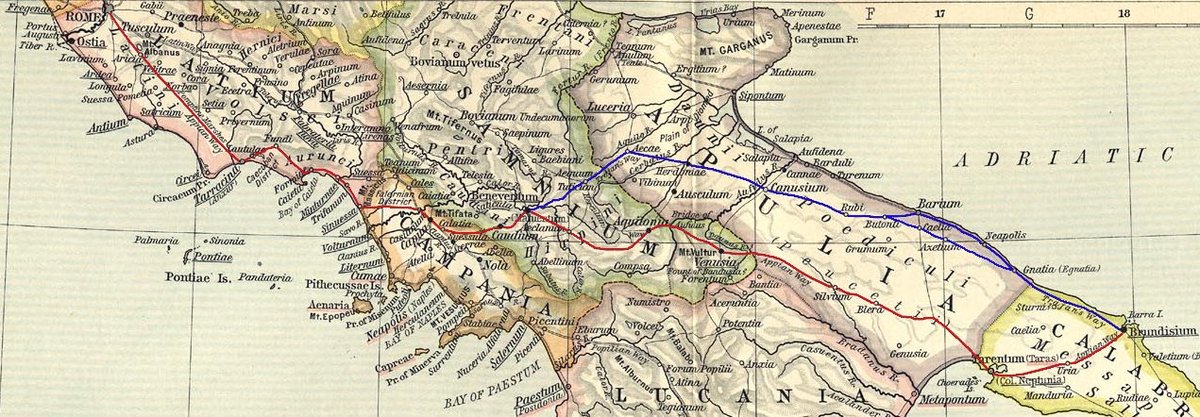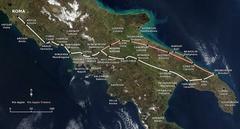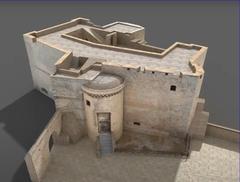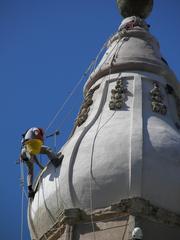
Via Traiana Visiting Hours, Tickets, and Historical Sites in Monopoli, Italy
Date: 14/06/2025
Introduction: Discover the Via Traiana in Monopoli
The Via Traiana is one of the most outstanding ancient Roman roads, constructed in the early 2nd century CE by Emperor Trajan. Built to streamline travel between Beneventum (modern Benevento) and Brundisium (modern Brindisi), this route not only facilitated military and commercial movements but also shaped the development and cultural identity of towns along its path—especially Monopoli. Today, Monopoli’s proximity to the Adriatic coast and the Via Traiana’s route has solidified its role as a historic crossroads, influencing its urban structure, economic growth, and traditions from antiquity through the Middle Ages.
Modern visitors can experience both the tangible remains—such as ancient paving stones, archaeological parks, and Roman milestones—and the region’s living traditions, including medieval churches, castles, and centuries-old olive groves. The Via Traiana’s scenic landscapes—rolling olive groves, masserie (traditional farmhouses), and striking coastal vistas—make it an appealing destination for history buffs, hikers, cyclists, and cultural explorers.
Monopoli features well-maintained sites, including Castello Carlo V, the archaeological park at Capitolo, and the nearby Egnazia Archaeological Park. Many of these are accessible via guided tours and offer practical amenities for visitors. The recent UNESCO World Heritage inscription of the Via Traiana, under “Via Appia Regina Viarum,” highlights its international significance and ensures ongoing preservation.
This guide provides essential information about visiting hours, ticketing, routes, and travel tips to help you appreciate the Via Traiana’s enduring legacy in Monopoli. Whether you choose to walk or cycle the ancient paths, immerse yourself in archaeological wonders, or indulge in Apulian culinary traditions, the Via Traiana is a portal to Italy’s rich historical and living heritage. For planning resources, consult the Audiala app and official tourism websites.
Set forth on a journey across the crossroads of civilizations and landscapes that have shaped Monopoli’s history for millennia (Explore Via Traiana: Monopoli, Monopoli Tourism, The Thinking Traveller).
Table of Contents
- Discovering the Via Traiana: History and Cultural Impact
- Practical Visitor Information
- Comprehensive Guide: Visiting Hours, Route, and Travel Tips
- Historical Context and Development
- Walking, Cycling, and Thematic Tours
- Summary and Call to Action
- References and Official Sources
Discovering the Via Traiana: History and Cultural Impact
Origins and Construction
Commissioned by Emperor Trajan, the Via Traiana was built to offer a more efficient alternative to the Via Appia, reducing travel time between Beneventum and Brundisium by about a day. Its robust construction—layered stone foundations and durable paving—set the standard for Roman engineering. The Arch of Trajan in Beneventum commemorates the road and Trajan’s accomplishments.
Route and Key Features
The Via Traiana branched from the Via Appia at Beneventum, passing through important settlements like Canusium, Rubi, and Egnatia before ending at Brundisium. Monopoli, located near this route, became a vital waypoint. The road’s enduring features include bridges, milestones, and rest stations, with strategic drainage and straight alignments evident in surviving sections.
Historical Importance
The Via Traiana was crucial for Roman administration and military logistics, connecting Rome with its eastern provinces through Brundisium’s port. It remained significant during the late Roman and early medieval eras, fostering economic and cultural growth in towns like Monopoli.
Monopoli’s Local Context
Monopoli’s position near the Via Traiana shaped its development from the Messapian era through the Middle Ages. The town’s historic center overlays Roman foundations, preserving the ancient road’s influence in its layout and identity as a crossroads on the Adriatic coast.
UNESCO World Heritage Status
In 2024, the Via Traiana, together with the Via Appia, was recognized as a UNESCO World Heritage Site under “Via Appia Regina Viarum,” underlining its global cultural and historical significance.
Practical Visitor Information
Visiting Hours and Ticket Details
- Arch of Trajan (Benevento): Open daily 9:00 AM–6:00 PM. Tickets ~€6 (discounts for EU citizens under 25 and free entry on first Sundays). Tickets available online and at the site.
- Egnazia Archaeological Site: Summer hours 8:30 AM–7:00 PM; shorter in winter. Admission fees vary—check the Apulian heritage website.
- Monopoli Old Town: Open year-round and free to explore.
Guided Tours and Events
- Guided walking and cycling tours are offered by local agencies, often including historic and archaeological highlights.
- Special summer festivals may feature historical reenactments and immersive events.
Accessibility
- Many major sites have ramps and accessible facilities, but ancient or rural terrain may present challenges. Contact visitor centers for specific accessibility details.
Best Photo Spots
- The Arch of Trajan and Monopoli’s coastal stretches provide excellent opportunities for photography, especially at sunrise and sunset.
Getting There and Around
- Monopoli is accessible by train or car from Bari. Local buses and taxis connect key sites.
Recommended Resources
- The Audiala app provides maps, historical context, and audio tours for the Via Traiana and Monopoli.
Comprehensive Guide: Visiting Hours, Route, and Travel Tips
Accessibility and Route Overview
The Via Traiana through Monopoli is an open public route, accessible year-round. Facilities like masserie and chapels have typical opening hours (9:00 AM–7:00 PM). The route is mostly flat, suitable for walkers and cyclists, though some parts may be uneven.
Landscape and Key Sights
- Olive Groves and Farmland: Home to millennia-old olive trees and vineyards (Outdooractive).
- Trulli and Masserie: Experience traditional Apulian architecture and local produce tastings.
- Coastal Views: Enjoy panoramic Adriatic vistas and access to beaches like Cala Porta Vecchia and Porto Rosso (Rachel IRL).
Points of Interest
- Monopoli’s Historic Center: Explore Baroque churches, whitewashed streets, and Castello Carlo V (Tourist Secrets).
- Rural Chapels and Ancient Markers: Key sites for local festivals and religious history.
- Natural Features: Mediterranean flora, wildflowers, and birdwatching opportunities.
Guided Tours and Events
- Book guided walking or cycling tours for historical insights.
- Events like the Festa della Madonna della Madia in September provide immersive experiences.
Practical Tips
- Getting There: Monopoli is well-connected by train and road.
- Signage: Some waymarking exists, but GPS or detailed maps are advised.
- Duration and Difficulty: Options range from short walks to full-day hikes.
- Facilities: Masserie and villages offer rest stops; carry water in summer.
- Accommodation: Choose from hotels in Monopoli’s center to agriturismi along the route.
Frequently Asked Questions (FAQ)
Q: Do I need tickets to visit the Via Traiana sites?
A: The route itself is free. Some museums or archaeological sites may charge admission—check before visiting.
Q: When is the best time to visit?
A: Spring (April–June) and autumn (September–October) offer pleasant weather and beautiful landscapes.
Q: Can children and families enjoy the route?
A: Yes, the mostly flat terrain is suitable for families.
Q: Are guided tours available?
A: Yes, local agencies offer various guided options.
Q: Can I cycle the Via Traiana?
A: Yes, cycling is popular and recommended for exploring longer stretches.
Photography and Visitor Experience
Capture ancient road segments, olive groves, and sea vistas, especially during golden hour. Enhance your visit with local festivals and masseria tastings.
Safety and Broader Itineraries
Bring sun protection and water, particularly in summer. Stay alert on shared roads and respect local wildlife. Combine your Via Traiana journey with visits to Egnazia or coastal towns like Polignano a Mare (Mapcarta).
Historical Context and Development
Archaeological Features and Sites
- Traces of the Ancient Road: Visible stone alignments in rural areas (italia.it).
- Grotta delle Mura: Prehistoric cave with artifacts (mapcarta.com).
- Masserie and Hypogean Oil Mills: Fortified farmhouses and ancient oil mills reflect agricultural heritage.
Cultural Legacy and Agricultural Heritage
- Crossroads of Civilizations: Monopoli absorbed influences from Greeks, Byzantines, Normans, and Venetians (italia.it).
- Religious and Social Life: Medieval churches, cathedrals, and processions show the route’s spiritual importance.
- Agricultural Heritage: Ancient olive groves and masserie continue to shape the local economy.
Preservation and Research
- Archaeological Excavations: Bronze Age and Roman settlements uncovered near the route.
- Conservation: Ancient road segments are preserved within modern infrastructure; interpretive signage aids visitors (thethinkingtraveller.com).
Visitor Experience
Walking, Cycling, and Thematic Tours
Explore themed routes on foot or by bike. Guided tours focus on archaeology, gastronomy, and local traditions. Museums in nearby towns like Egnazia deepen the historical context (thethinkingtraveller.com).
Community Engagement
Festivals, educational programs, and local events celebrate the Via Traiana’s continuing role in Monopoli’s identity.
Walking, Cycling, and Thematic Tours
Key Sites and Itineraries
- Parco Archeologico della Via Traiana - Capitolo: Open daily, typically 9:00 AM–7:00 PM. Free entry; some tours require advance booking.
- Church of San Giorgio: Accessible during park hours.
Cycling Routes and Recommendations
A popular 45 km bike route extends from Monopoli to Ostuni, suitable for gravel or touring bikes. Download GPX tracks for navigation (LaVia.cc).
Special Events and Seasonal Tips
Check local listings for festivals, guided night tours, and olive harvest experiences.
Selected Points of Interest
- Torre Cintola: Ruins of a coastal watchtower.
- Chiesa Rupestre di San Giorgio: Medieval rock church.
- Grotta di Porto Giardino: Archaeological coastal cave.
- Capitolo Beach: Ideal seaside stop.
Summary and Call to Action
The Via Traiana in Monopoli is a tapestry of history, culture, and nature. From Roman milestones to olive groves and medieval castles, the route offers immersive experiences for every traveler. Improved accessibility, guided tours, and local events ensure a welcoming environment for diverse interests. As a UNESCO World Heritage site, the Via Traiana’s legacy is safeguarded for future generations.
For a memorable journey, use resources like the Audiala app for interactive maps and audio guides, and stay updated with local events and travel tips. Plan your trip, explore the ancient road, and share your adventure to inspire others to discover Monopoli’s rich heritage (Italia.it, Bon Traveler, Tourist Secrets).
References
- Discovering the Via Traiana: Visiting Hours, Tickets, and Historical Sites in Monopoli, 2024
- Via Traiana Monopoli: Visiting Hours, Route, and Travel Tips, 2024
- Exploring Via Traiana in Monopoli: Visiting Hours, Tickets, and Historical Sites in Puglia, 2024
- Via Traiana in Monopoli: Visiting Hours, Tickets, Guided Tours, and Cycling Routes, 2024
- Bon Traveler: Monopoli Italy Travel Guide, 2024
- Tourist Secrets: A Curated Guide to Monopoli, 2024
- Rachel IRL: Monopoli in Puglia Travel Blog, 2024
- LaVia.cc: Via Traiana Cycling Routes, 2024
- Two for the World: Puglia Road Trip Itinerary, 2024






